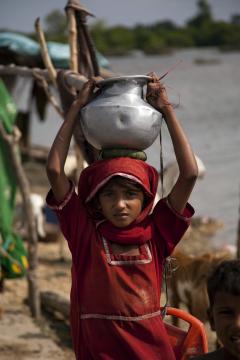SRSG Viewpoints
New Articles
Geographical movement has been a constant in human development. Today, however, widespread violence, armed conflict, violent crime, food insecurity and environmental degradation have reached such levels that we are witnessing an unprecedented level of mass human movement around the globe. Many of those on the move are children: girls and boys under the age of 18 who feel compelled to leave their homes and communities to flee violence or oppression or to seek safety and protection elsewhere.
The rights of children of parents sentenced to the death penalty or subject to execution are seldom discussed and have largely been neglected. It is crucial that we bring the child’s perspective into these reflections
Protecting children from bullying and other forms of violence at school is not just an ethical imperative or a laudable aim of education policy: it is a question of human rights.
The world stands at a pivotal moment towards ending violence against children and realizing the noble vision of the UN Convention on the Rights of the Child. In September 2015, the Member States of the United Nations will gather to agree on the...
On Friday 25 September, the new global sustainable development agenda was unanimously adopted by the Member States of the United Nations. The new agenda includes for the first time a specific target (16.2) to end all forms of violence against children, and ending the abuse, neglect and exploitation of children is mainstreamed across several other violence-related targets. This is the time to celebrate the adoption of the new development agenda and highlight how the global community can make the vision of target 16.2 a reality for all the world's children.
The prevention and elimination of violence against children is an ethical imperative founded on the human dignity of children and their rights to protection from maltreatment enshrined in the Convention on the Rights of the Child and its Optional Protocols, as well as a range of other human rights instruments. The almost universal ratification of the CRC is a potent symbol of the global consensus around the principle that no violence is ever justifiable and all violence can be prevented.
The world stands at a pivotal moment towards ending violence against children and realizing the noble vision of the UN Convention on the Rights of the Child. In September 2015, the Member States of the United Nations will gather to agree on the new sustainable development agenda. In the short period from now until the end of September, the world has a golden opportunity to ensure that ending this most severe violation of children’s rights – the phenomenon of violence against children – remains at the heart of this global strategic agenda.
In 2014, as we mark the 25th anniversary of the adoption of the Convention on the Rights of the Child, the protection of children from violence has gained increasing global priority. There has been an incremental development of legislative and policy reform, and enhancements in child protection systems. However, even as we celebrate these notable achievements, we must also recognize that progress has been too slow, too uneven and too fragmented to make a genuine breakthrough. Children remain at risk of violence in every setting, including those where they should feel safest – in schools, in care and justice institutions, and within the home.
Still today, millions of girls continue to suffer the detrimental impact of physical, mental and sexual violence in the home, at school, in the community, in institutional care and in justice institutions. Evidence from some countries show that amongst the girls involved in prostitution and drug abuse, 80-90 percent have been exposed to sexual abuse and/or other forms of violence in their homes.
The protection of boys and girls from all forms of violence is a concern the international community cannot afford to omit from the post-2015 development agenda.
In fact, freedom from violence is indispensable to a sustainable future in which children will be able to grow up healthy, well-nourished, resilient, well-educated, culturally sensitive and protected from abuse and neglect. A future in which equity and social progress will be a reality for all members of the human family.
With the effective implementation the world over of the Conventions on the Rights of the Child and of the Rights of Persons with Disabilities, there can be a paradigm shift in the way the human rights of children with disabilities are promoted, protected and fulfilled. This shift is urgently needed!
The life of children with disabilities is surrounded by stigma, discrimination, cultural prejudices, ill- perceptions and shocking invisibility. Unfortunately, it is also dramatically marked by heightened risks of violence, neglect, injury and exploitation.
The world comes together on June 12 to rally efforts in the fight against child labour, and to bring to an end the plight of the more than 215 million children worldwide who are victims of this serious violation of their rights.
We live in a globalizing world, in constant change. The search for better economic opportunities and for a better lifestyle, on the one hand; and political instability and armed conflicts, violence and discrimination, climate change and natural disasters, on the other, are some of the reasons behind international and internal migration flows – from South to North, and more significantly, across and within countries in the South.
The protection of children from all forms of violence is a fundamental right, which the international community has solemnly pledged to safeguard for all children, everywhere and at all times. Unfortunately, violence remains a harsh reality for millions of children around the world. Violence hampers a child’s development, learning abilities and school performance. It inhibits positive relationships, provokes low self-esteem, emotional distress and depression and, at times, leads to risk taking, self-harm and aggressive behaviour.



